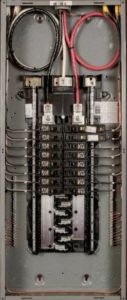What is an Electrical Sub-Panel?
An electrical sub-panel is simply a secondary electrical distribution panel inside the home or on the property. Sub-panels generally receive electricity from a home’s main electrical service 
Do I need to Install an Electrical Sub-Panel?
There are three primary reasons for choosing to install an electrical sub-panel. The first and most common are space constraints. In this scenario, the main electrical circuit breaker panel does not have enough available spaces to add a new branch circuit. Alternatively, where added protection is code required or homeowner elected, 
Wiring Efficiency on New Construction or Addition
The second reason for installing an electrical sub-panel involves wiring efficiency, particularly on new home construction or home additions. When the electrical service panel is located on one side of a home versus near the center, individual electrical home run branch circuits may become very long, which is particularly problematic in larger homes. Longer electrical wires have inherently more resistance to current flow, and therefore generate far more heat. Additionally, long electrical circuits can experience power quality issues such as excessive voltage drop. Higher quantities of heat can degrade wire insulation and increase the probability of home fires while large voltage drops create excessive wear and tear on appliances, particularly those equipped with electric motors or sensitive electronics. Additionally, longer electrical circuits require significantly more copper wire and are much more expensive to install. Installing an electrical sub-panel in a location effectively shortens multiple home run circuits while achieving significant efficiencies. This is accomplished by installing one large feeder circuit from the electrical main panel to supply electricity to the sub-panel. Consequently, each individual electrical branch circuit from the sub-panel becomes shortened. This is accomplished by terminating the branch circuits at the much closer sub-panel versus installing longer wires back to the distant electrical service panel. An electrical sub-panel installation generally is a cost-effective option, producing less heat and creating less voltage drop.
Homeowner Convenience
Finally, the third primary reason for installing an electrical sub-panel is convenience. If, like most homes, the electrical main panel is located in a basement or far distant part of home, the homeowner must traverse one or more flights of stairs and potentially cross the length of the home, and potentially move personal property to reach the main electrical panel. This is especially problematic in larger homes with two or more stories, a basement, and homes exceeding 4000 square feet. Adding an electrical sub-panel to each floor or section of a home can 
Performance Group Electrical Sub-Panel Installation in Kansas City
An electrical sub-panel can be a practical component of a home’s electrical system. When chosen, a quality electrical sub-panel installation should be both, code compliant, and electrically sound delivering an efficient, convenient and cost-effective solution. Consider hiring a licensed electrical professional with expert knowledge to protect your family and your home. An investment in a safe electrical sub-panel can save tens of thousands in fire restoration, and most importantly save lives.
At Home Performance Group, we continue to invest in electrical technical training so we can safely install electrical sub-panels. We have performed numerous service upgrades, main panel replacements, and sub-panel installations for our clients.
If you are interested in a no-cost in-home consultation, schedule with a Solutions Advisor today.

Article by Larry L. Motley Jr., 18 October 2021
Larry is a graduate of both Wentworth Military Academy and Missouri Western State University earning a double bachelor’s degree in Economics and Finance. Additionally, he maintains six professional tradesman licenses in two states and advanced credentialing in green technology, project and program management, and process improvement. Larry is a three-time combat veteran having served in Operation Iraqi Freedom, Operation New Dawn, and Operation Inherent Resolve. He continues to serve through a value-based building science company focused on providing clients the best design, highest quality installation, and most honest repair services in the community.


Featured Service Areas:
| Missouri | Kansas | ||||
|---|---|---|---|---|---|
|
Belton Blue Springs Cameron Excelsior Springs Gladstone Holt |
Independence Kansas City Kearney Lathrop Lawson Lee's Summit |
Liberty North Kansas City Parkville Platte City Plattsburg Polo |
Raytown Riverside Smithville Sugar Creek Weston |
Kansas City Lansing Leavenworth Leawood Lenexa |
Merriam Mission Mission Hills Praire Village Shawnee |






















